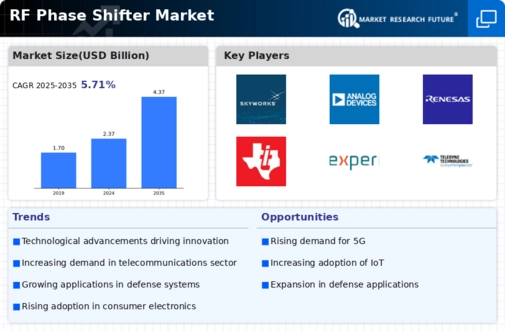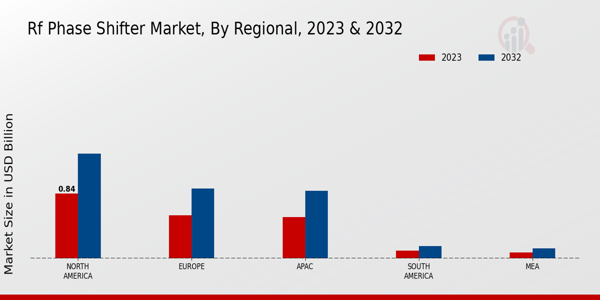Emergence of Smart Cities
The Global RF Phase Shifter Market Industry is benefiting from the emergence of smart cities, which leverage advanced technologies to improve urban living. RF phase shifters are integral to the infrastructure of smart cities, facilitating efficient communication between various devices and systems. As cities adopt smart grids, traffic management systems, and public safety networks, the demand for reliable RF components increases. This trend reflects a broader commitment to enhancing urban environments through technology, suggesting a sustained growth trajectory for the RF phase shifter market. The integration of these components is essential for ensuring seamless connectivity and data exchange in increasingly complex urban ecosystems.
Market Growth Projections
The Global RF Phase Shifter Market Industry is projected to witness substantial growth, with estimates indicating a rise from 2.37 USD Billion in 2024 to 4.37 USD Billion by 2035. This growth trajectory suggests a compound annual growth rate of 5.71% from 2025 to 2035, reflecting the increasing integration of RF phase shifters across various sectors. The market dynamics are influenced by factors such as technological advancements, rising demand for wireless communication, and the expansion of military applications. This upward trend in market value underscores the critical role that RF phase shifters play in modern technology, positioning them as essential components in future innovations.
Growth in Consumer Electronics
The Global RF Phase Shifter Market Industry is poised for growth due to the rising demand for consumer electronics. Devices such as smartphones, tablets, and smart home appliances increasingly rely on RF technology for enhanced functionality. As manufacturers strive to improve device performance and connectivity, RF phase shifters become essential components in optimizing signal transmission and reception. The market's expansion is indicative of a broader trend in consumer electronics, where the integration of advanced RF components is necessary to meet consumer expectations for high-speed and reliable connectivity. This growth is likely to contribute to a compound annual growth rate of 5.71% from 2025 to 2035.
Technological Innovations in RF Components
The Global RF Phase Shifter Market Industry is driven by ongoing technological innovations in RF components. Advances in materials science and manufacturing processes are enabling the development of more efficient and compact RF phase shifters. These innovations enhance performance characteristics such as bandwidth, power handling, and phase accuracy, making RF phase shifters more appealing for various applications. As industries seek to optimize their RF systems, the adoption of cutting-edge technologies is likely to accelerate market growth. This trend aligns with the overall trajectory of the RF components market, indicating a potential for sustained investment and development in the coming years.
Increasing Demand for Wireless Communication
The Global RF Phase Shifter Market Industry is experiencing a surge in demand driven by the rapid expansion of wireless communication technologies. As mobile devices proliferate and the Internet of Things continues to grow, the need for efficient signal processing becomes paramount. RF phase shifters play a crucial role in enhancing signal integrity and reducing interference in wireless systems. This trend is evident as the market is projected to reach 2.37 USD Billion in 2024, reflecting the industry's response to the increasing complexity of communication networks. The integration of RF phase shifters in 5G technology further underscores their importance in ensuring seamless connectivity.
Advancements in Military and Aerospace Applications
The Global RF Phase Shifter Market Industry is significantly influenced by advancements in military and aerospace applications. These sectors require highly reliable and precise RF components for radar systems, communication devices, and electronic warfare systems. The demand for sophisticated RF phase shifters is expected to grow as defense budgets increase globally, with countries investing in modernizing their military capabilities. The integration of RF phase shifters enhances the performance of phased array antennas, which are critical for advanced surveillance and targeting systems. This trend suggests a robust growth trajectory for the market, aligning with the projected increase to 4.37 USD Billion by 2035.
























